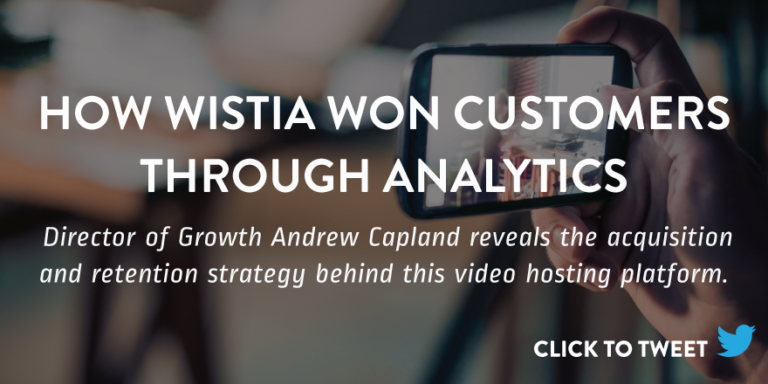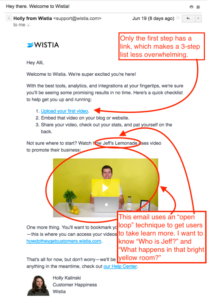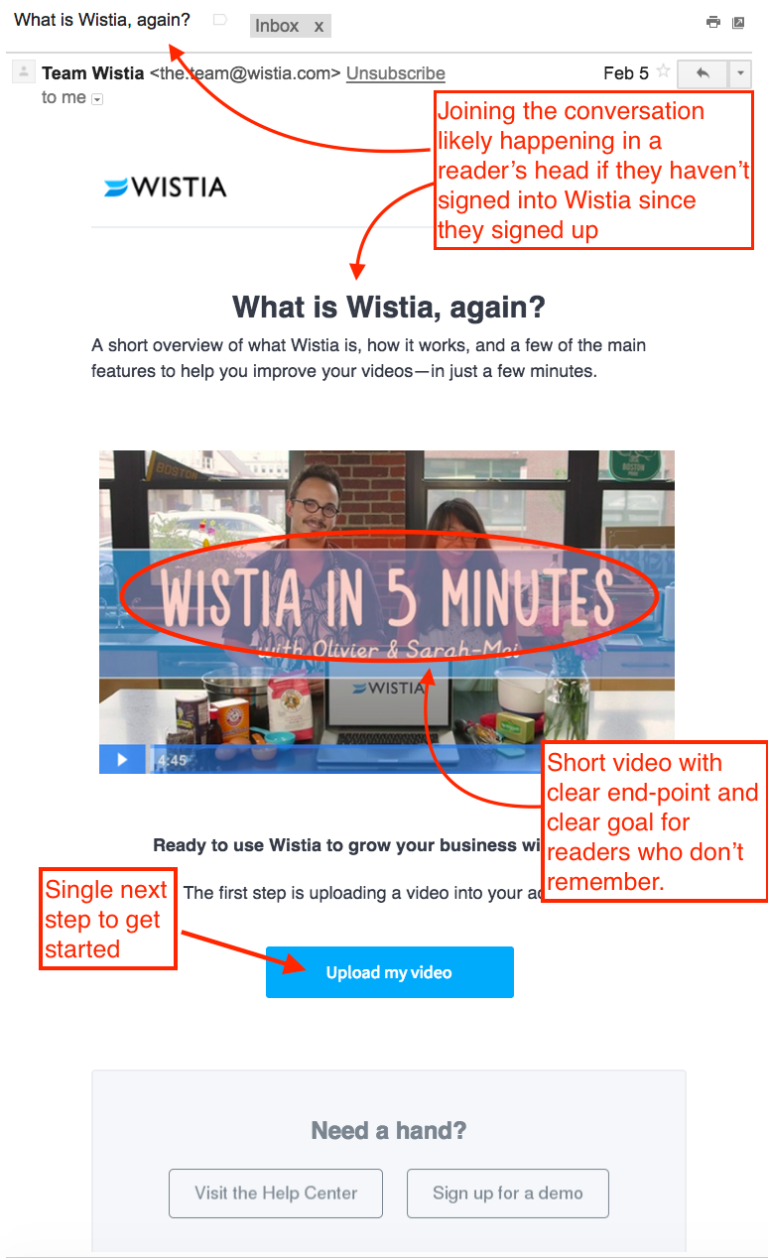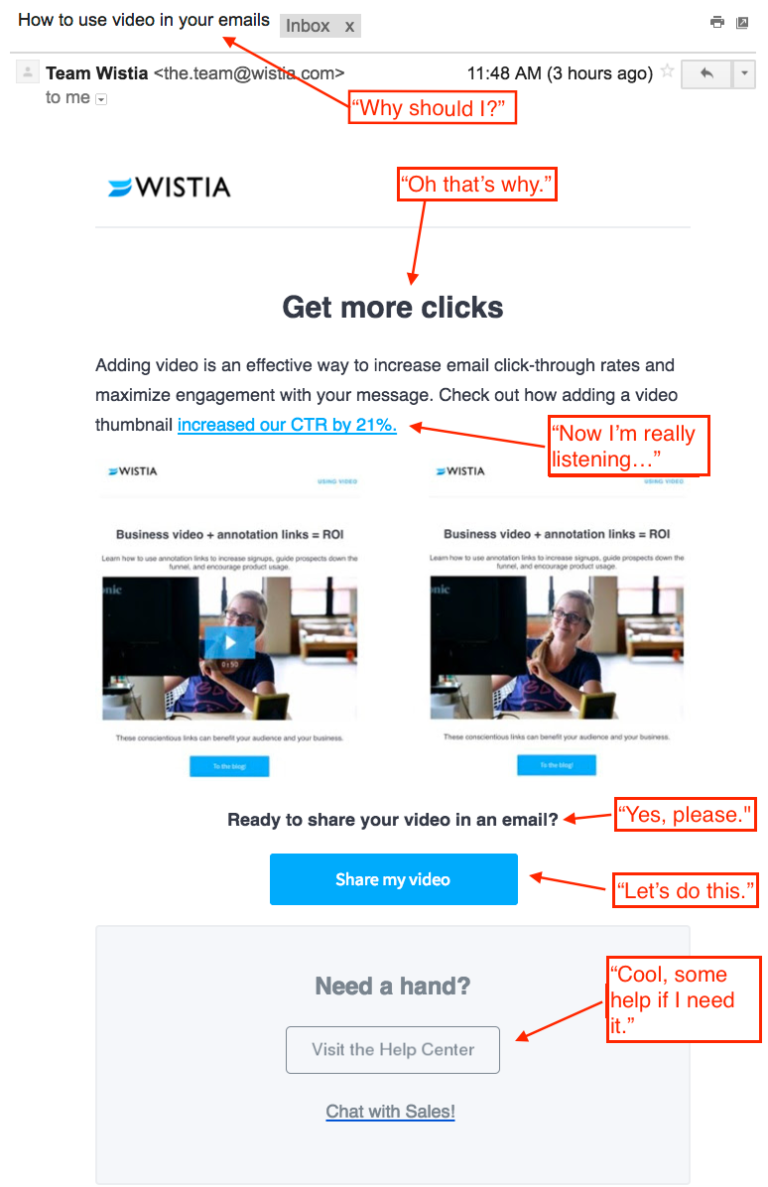How Wistia used data to transform its customer acquisition strategy
Andrew Capland wasn’t hired to do this job. Now the Director of Growth at Wistia, he originally joined the video hosting and analytics company to find out how to convert website visitors into account signups. But shortly into his tenure, Andrew and his team realized that they could tap into a bigger growth opportunity by focusing on what happened after prospects created new accounts.
After signup, some users uploaded videos. Others didn’t. Some shared the videos they uploaded. Many didn’t. And some free accounts upgraded to paid accounts – but most didn’t.
That’s when Andrew and his team decided to pivot focus from increasing signups to increasing the right kind of signups. After discovering what differentiated accounts that upgraded from accounts that didn’t, they designed a free trial intended to help best-fit customers get the most out of Wistia.
In this interview, Andrew talks about how the Wistia team used qualitative and quantitative data to uncover the differences between the 20 percent of new accounts likely to upgrade and the 80 percent who didn’t.

Alli Blum: When did your strategy change from onboarding more users to onboarding better users?
Andrew: We learned pretty quickly that more isn’t necessarily better. Even though we had successfully increased the number of new signups the previous year, they weren’t high-quality accounts. They weren’t turning into paying customers. We dug into our data and found that only about 20 percent of our signups were actually valuable to us. And that really changed the way that we thought about new account generation, user onboarding, activation, and how to encourage new accounts to purchase.
Alli: How did you determine what differentiated that valuable 20 percent?
Andrew: We followed the data. We asked, “What about these accounts makes them more likely to become a customer?
At first, we didn’t go super in-depth. We looked at the high level and tried to see whether there were any geographic indicators. Were there areas of the world where users were more likely to turn into Wistia customers? The answer was yes.
We also looked at different types of email domains. We have a lot of signups for Wistia from personal email accounts like Gmail, Hotmail, AOL, etc. Although those users love to use Wistia for free, they usually don’t end up becoming paying customers.
We have a freemium pricing model, so we want people to use our tool and tell their friends about it. But when we realize that a user has a low likelihood of becoming a paying customer, we start tracking that user differently.
Alli: What tool did you use to do all this tracking?
Andrew: We use Mode. It’s our business intelligence tool of choice and it’s connected to our internal database. We also dug into Mixpanel, along with our CRM.

Wistia’s welcome email succeeds because it uses an open-loop strategy to get users to take one action only.
Alli: So you’ve got actionable data – what actions did you take because of it?
Andrew: We started by tracking signups differently. Once we actually started producing reports on a weekly basis, we could better predict how much revenue we would generate by the end of the month. We also started to redo previous A/B tests on our website based on our new goals.Now, we’re trying to create experiences that drive more activated accounts. What should be the first thing visitors see when they log into Wistia? What can we do inside of our new user experience to customize the flow so that the user will see success? What does success look like for someone who comes from a business email domain versus a personal Gmail account?
We’ve done user research to inform how we will change those flows. We anticipate that it will create more activated accounts. And that activation will probably look different for different types of users, and that’s okay.
Alli: How are you conducting that user research?
Andrew: We will ask existing customers, “Why did you sign-up for this tool in the first place? What were you most excited to do? What jobs did you hire Wistia to do for you? What do you like most about being a Wistia customer? What enticed you to pull out your credit card and upgrade to a paid account?”
We’ll supplement those conversations with surveys and Mixpanel data. We’ll also use UserTesting.com to help us validate new flows before we implement them. Then, when we make major changes, we’ll A/B test everything.
Alli: It sounds like you’re starting to dig in beyond geography and email handles as key differentiators. Is that accurate?
Andrew: We think about our user experience as a program. It’s ongoing. We’re always tinkering with it. In the past, we only had one recipe: users came through the door, and we treated them all the same. We applied the same set of success milestones to every user, even though they followed different paths inside the product. We tracked our activation rate and thought it was reasonable based on what we had heard from other companies.
What we’re doing now is the hard work. Treating people differently means tracking and testing them differently. Success might look differently for all of them, and that’s tricky.

Wistia sends this email to new signups who haven’t yet uploaded a video. The message meets readers where they are and provides a compelling reason for signing back in.
Alli: Can you say a little more about your signup recipes?
Andrew: We enrich signups using third-party data to learn more about our users: what tools they are using, what industries they are coming from, what actions they’ve taken inside of their account, their geographic location – all of that good stuff. Then, we use that information to customize our email approach.
This approach is sophisticated – especially compared to what happens inside the product itself. We want to move towards one consistent approach across all channels. Users should know, “This is my one next step. This is what I should do to see success.” We try to learn user goals so we can suggest ways for users to achieve them and see value as quickly as possible, consistently.
Deeper customer research has allowed us to gather more information that will inform how we rebuild our channels to have a similar – and likely more complex – approach.
Alli: Let’s talk about that sophisticated email strategy. How did you develop it?
Andrew: When I started at Wistia, we only had three emails, and we would send them out to every person that signed-up for an account.
Now, every new account receives a welcome email with links that the user should bookmark, like our help center. Then, we send specific emails based on account behavior.
There are three basic tracks. Track one is for users who haven’t uploaded a video, and it has seven emails that are sent out over three months. At first, those emails tell the users different ways they can upload a video. Then, if the user still hasn’t uploaded a video after a couple of weeks, it switches to information on how to make the first video. Then, it switches to marketing content because we assume that if users haven’t uploaded a video within the first week, they probably don’t have one.
The second track is for users who have a video in their account but haven’t shared it with anyone. Again, it’s the same deal: it’s a seven-email track that goes out over three months. The first couple emails say, “You haven’t shared a video. Here’s how to share your video with someone else and generate stats.” We explain how to share it over email and on social media and how to embed it on the user’s website. At a certain point, we switch our approach. We start telling users about features they’ll unlock after they embed their first video or share it with someone.
We want to encourage users to view their stats, so we have a couple of emails that tout the benefits of using our stats feature and other advanced features. We also send links to customer case studies, testimonials, third-party review websites, and blog articles written by other companies that talk about why they like Wistia or why they chose to become our partner – things like that.
That’s the end of the sequence.

This email is part of the sequence for new users who have uploaded a video but haven’t shared it. It answers the question “So what?” by giving the reader a relevant reason to share a video over email.
Alli: Who wrote the emails?
Andrew: I wrote the three base email tracks – the 21 emails that we just talked about. Most of those are still in place today, but we just hired a really talented email marketing person who has been chomping at the bit to get her hands on those emails.
Alli: Joanna Wiebe of Copyhackers and Airstory came in to write some of them. Which emails did she work on?
Andrew: She was working on our third email track – the one directed at users who have already uploaded a video and shared it. It’s a sales-enablement track intended to help them do more with Wistia and compare Wistia to other tools out there.
Alli: What was different about working with a copywriter versus someone who has a hand in all aspects of marketing?
Andrew: She had a set approach to finding the right information.
She reviewed websites and collected information as said by the user. It wasn’t something our team had thought to do previously.
We just figured that we knew what our users liked from talking to a few of them and that we could write effective copy based on the gut feeling we got from those conversations. She proved to us the importance of really listening to customers and getting clear feedback. She also used previous knowledge about what had helped other companies succeed.
Alli: Did her emails get better results?
Andrew: Definitely. The emails she wrote for us got more opens and clicks than anything that we had written in the past, which was a nice early indicator.
Our team was also excited about her emails because they generated more successful accounts for us. More accounts stayed on for longer, and there were more paying customers – despite the small sample size.
We took the lessons from that experiment and applied them to all of our emails to maximize value in the long-term.
To learn more about Andrew Capland and his thoughts on growth marketing at Wistia follow him on Twitter.
Alli Blum helps SaaS apps optimize their onboarding and retention messaging at howdotheygetcustomers.com


